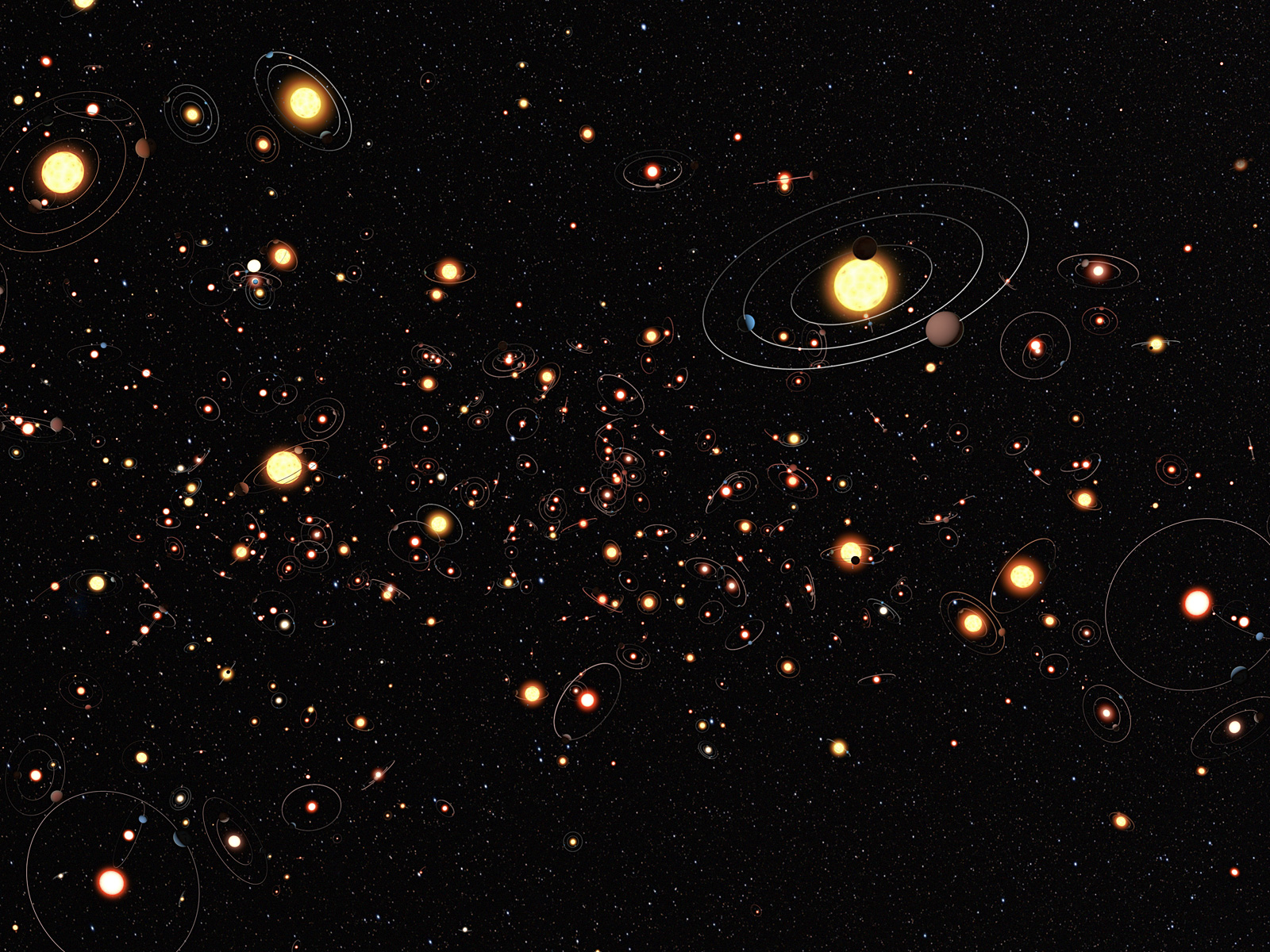It looks like you're using an Ad Blocker.
Please white-list or disable AboveTopSecret.com in your ad-blocking tool.
Thank you.
Some features of ATS will be disabled while you continue to use an ad-blocker.
share:
Happy American Thanksgiving (I'm Canadian eh?)!
Um, been still pondering over this intriguing and curious question..
There is a real problem, I've come to realize with the living exomoon hypothesis (whether the moon is tidally locked or not), and that's the extreme temperature fluxuations, which is not to say that some form of life could not take hold with by a type of on-off bio-rythm which is adapted to the fluctuations, but it's unlikely, in the extreme, to be hospitable towards the type of animal life seen here on Earth or anything even remotely similar ie: no earth-like exomoons are possible.
It's possible I suppose to find one that is not tidally locked with a highly eccentric orbit such that it never enters the shadow of it's host planet ie: an orbit circling it's host at about a 90% orientation line of sight to it's sun, but that kind of situation would be exceedingly rare in the extreme.
Using Earth as the analogue (analogous example), due to it's location in our Habitable Zone and it's axial tilt with an eliptical orbit resulting in the four seasons beyond the equator, the long term, sustained temperature stability over a very VERY narrow band within any given ecosystem is quite obviously responsible for the evolution of life as we see it here on earth, as well as the presence of liquid water encompassing the entire planet, extending all the way to the poles and covering well over 90% of the entire surface (where liquid water is present).
A tidally locked planet, as many are, would not of course have oceans enveloping it, although temperatures would be more stable than on an exomoon, depending on it's axis and/or elliptical orbit, so in theory, a rocky world with water would have a habitable zone across a narrow band along the area of threshold between darkness and light. We're not apt to find night time city lights or even animals walking and flying around, on such a planet, however.
Take our own moon for example, and note the moon phases on our side with the shadow of the earth sequentially blocking light in the waxing and waning process, and because of it's orbit around the earth on the "dark side" (from our POV), the situation is no better going from super hot, to super cold, in a very short time frame.
Thus the "habitable zone" (where liquid water can be present) would in almost all cases be in a very very small region of an exomoon, but it's possible that such a region could exist.
We would not find any "Pandoras" like in the movie Avatar in other words.
Just keeping it real. This is not a biased analysis, because I really wanted for there to be living, Mars/Earth-sized, Earth-like exomoons circling Gas Giants in the habitable zone.
Best Regards,
NAM aka Bob
Um, been still pondering over this intriguing and curious question..
There is a real problem, I've come to realize with the living exomoon hypothesis (whether the moon is tidally locked or not), and that's the extreme temperature fluxuations, which is not to say that some form of life could not take hold with by a type of on-off bio-rythm which is adapted to the fluctuations, but it's unlikely, in the extreme, to be hospitable towards the type of animal life seen here on Earth or anything even remotely similar ie: no earth-like exomoons are possible.
It's possible I suppose to find one that is not tidally locked with a highly eccentric orbit such that it never enters the shadow of it's host planet ie: an orbit circling it's host at about a 90% orientation line of sight to it's sun, but that kind of situation would be exceedingly rare in the extreme.
Using Earth as the analogue (analogous example), due to it's location in our Habitable Zone and it's axial tilt with an eliptical orbit resulting in the four seasons beyond the equator, the long term, sustained temperature stability over a very VERY narrow band within any given ecosystem is quite obviously responsible for the evolution of life as we see it here on earth, as well as the presence of liquid water encompassing the entire planet, extending all the way to the poles and covering well over 90% of the entire surface (where liquid water is present).
The earth's average temperature is around 14 to 15 degrees Celsius and has a range of 70.7 degrees Celsius, from the coldest region to the hottest.
A tidally locked planet, as many are, would not of course have oceans enveloping it, although temperatures would be more stable than on an exomoon, depending on it's axis and/or elliptical orbit, so in theory, a rocky world with water would have a habitable zone across a narrow band along the area of threshold between darkness and light. We're not apt to find night time city lights or even animals walking and flying around, on such a planet, however.
Take our own moon for example, and note the moon phases on our side with the shadow of the earth sequentially blocking light in the waxing and waning process, and because of it's orbit around the earth on the "dark side" (from our POV), the situation is no better going from super hot, to super cold, in a very short time frame.
The temperature on the Moon ranges from daytime highs of about 130°C = 265°F to nighttime lows of about -110°C = -170°F
Seasons
The Moon's axial tilt with respect to the ecliptic is only 1.5424°, much less than the 23.44° of the Earth. Because of this, the Moon's solar illumination varies much less with season, and topographical details play a crucial role in seasonal effects. From images taken by Clementine in 1994, it appears that four mountainous regions on the rim of Peary crater at the Moon's north pole may remain illuminated for the entire lunar day, creating peaks of eternal light. No such regions exist at the south pole. Similarly, there are places that remain in permanent shadow at the bottoms of many polar craters, and these dark craters are extremely cold: Lunar Reconnaissance Orbiter measured the lowest summer temperatures in craters at the southern pole at 35 K (−238 °C) and just 26 K close to the winter solstice in north polar Hermite Crater. This is the coldest temperature in the Solar System ever measured by a spacecraft, colder even than the surface of Pluto.
en.wikipedia.org...
Thus the "habitable zone" (where liquid water can be present) would in almost all cases be in a very very small region of an exomoon, but it's possible that such a region could exist.
We would not find any "Pandoras" like in the movie Avatar in other words.
Just keeping it real. This is not a biased analysis, because I really wanted for there to be living, Mars/Earth-sized, Earth-like exomoons circling Gas Giants in the habitable zone.
Best Regards,
NAM aka Bob
edit on 29-11-2013 by NewAgeMan because: (no reason given)
I've been able to discern from the research that I've done so far, that the innermost planets of a solar system, including those in the "Habitable
Zone" have a tenancy to either tidal lock with their host star, or, at best, to have a very very very slow rate of rotation, on the way to tidal
locking, and that indeed - the reason that the Earth is not tidally locked and spins so fast, at 366 times per orbit, is due to the counteracting
tidal force of our single, giant moon, out of 166 in our solar system, which has the 2nd highest density, behind Io, and, that is the largest natural
satellite of a planet in the Solar System relative to the size of its primary, having 27% the diameter and 60% the density of Earth.
It should also be noted, as a sideline factoid, that Mercury has no moon and neither does Venus. Earth has one of course, and of the remaining five planets, not including Pluto, there are 164 moons.
It should also be noted, as a sideline factoid, that Mercury has no moon and neither does Venus. Earth has one of course, and of the remaining five planets, not including Pluto, there are 164 moons.
edit on 29-11-2013 by NewAgeMan because: typo
NewAgeMan
Using Earth as the analogue (analogous example), due to it's location in our Habitable Zone and it's axial tilt with an eliptical orbit resulting in the four seasons beyond the equator, the long term, sustained temperature stability over a very VERY narrow range within any given ecosystem is quite obviously responsible for the evolution of life as we see it here on earth, as well as the presence of liquid water encompassing the entire planet, extending all the way to the poles and covering well over 90 degrees of the entire surface (where liquid water is present).
The earth's average temperature is around 14 to 15 degrees Celsius and has a range of 70.7 degrees Celsius, from the coldest region to the hottest.
A tidally locked planet, as many are, because one side remains in darkness and the other, light, would not of course have oceans enveloping it, although temperatures would be more stable than on an exomoon, depending on it's axis and/or elliptical orbit, so in theory, a rocky world with water would have a habitable zone across a narrow band along the area of threshold between darkness and light. We're not apt to find night time city lights or even animals walking and flying around, on such a planet, however.
A couple of minor errors fixed, and a clarification added.
edit on 29-11-2013 by NewAgeMan because: (no reason given)
Even sceptics understand the odds of our planet being the only one with self-conscious life in entire universe is simply statistically impossible.
What is more interesting is our tendency to believe that intelligent extraterrestrial life would resemble our social systems with cities, light etc. (I understand that in this case such assumption was made to avoid the story appearing too far-fetched for the reader).
Even on earth there are no species that resembles humans. Apes come the closest but they do not have much else in common with us than two legs and two feet.
We simply cannot imagine what kind of lifeforms exists outside our own planet. Just look at the size of planet earth and start going from there on to the size of milky way, let alone other galaxies.
To put it another way - what are the chances you would find two completely identical grains of sand on a desert or how long it would take?
What is more interesting is our tendency to believe that intelligent extraterrestrial life would resemble our social systems with cities, light etc. (I understand that in this case such assumption was made to avoid the story appearing too far-fetched for the reader).
Even on earth there are no species that resembles humans. Apes come the closest but they do not have much else in common with us than two legs and two feet.
We simply cannot imagine what kind of lifeforms exists outside our own planet. Just look at the size of planet earth and start going from there on to the size of milky way, let alone other galaxies.
To put it another way - what are the chances you would find two completely identical grains of sand on a desert or how long it would take?
SCITK
Even sceptics understand the odds of our planet being the only one with self-conscious life in entire universe is simply statistically impossible.
What is more interesting is our tendency to believe that intelligent extraterrestrial life would resemble our social systems with cities, light etc.
It would be logical to assume a technological civilization would cluster in areas on its planet. You can call these areas whatever you want but they'd essentially be clusters of population.
As for artificial light. There's also good reasons to suspect vision will evolve in creatures on the surface of any planet receiving similar stellar flux as the one the Earth receives.
Vision is the most efficient sense for an organism to sense things outside of its immediate environment. All others, ie: echo location, magnetic navigation are less efficient.
So yes, intelligent aliens will probably have some form of eye(s) if they come from a planet similar to the earth (which our hypothetic planet around Keid is).
Providing artificial light in the darkness would make as much sense for them as it does for us.
The other thing you and others may have missed is the part about heat. All energy production that we know of and can conceive of produces heat either in the generation, storage or transmission. You name it: Hydrocarbon burning, wind, solar, nuclear fission, nuclear fusion, matter/anti-matter. So a telescope which detects infrared light/heat at that resolution would essentially be able to detect civilization through its use of energy.
I am not sure how many of you have seen this but it was the first picture of planets in another star system.
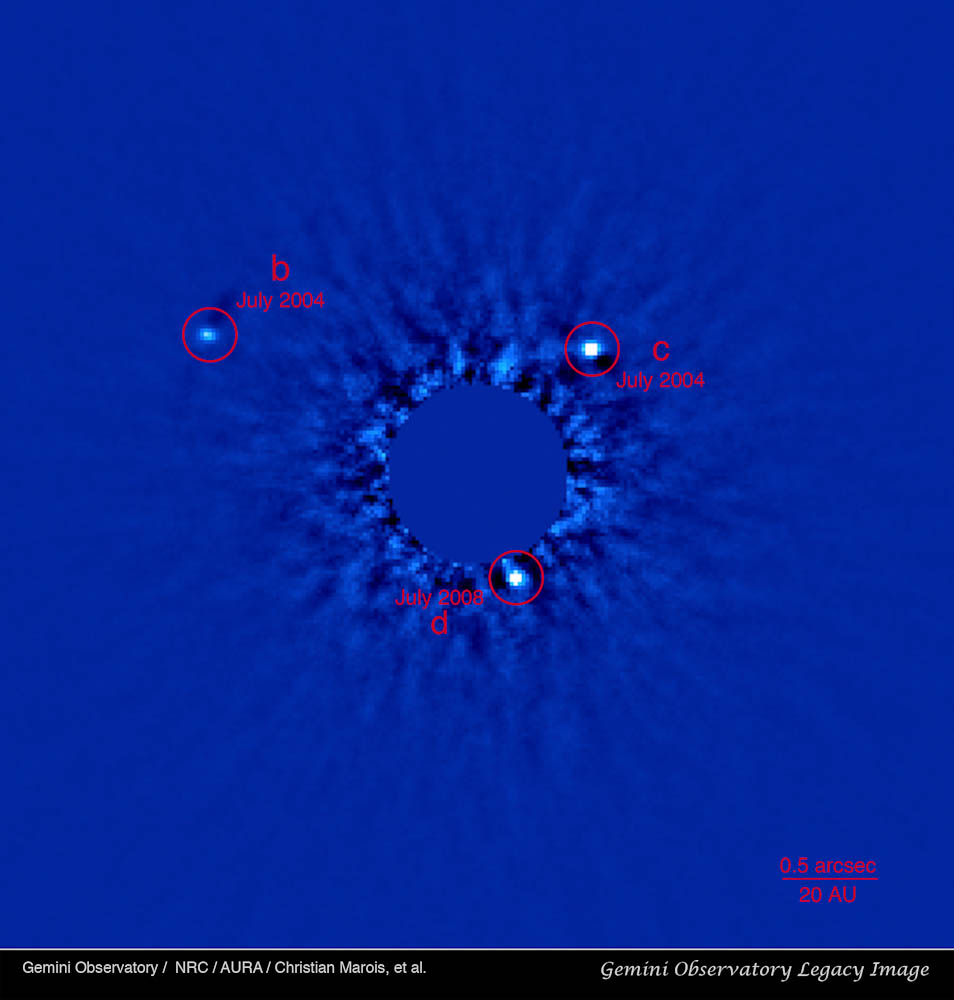
It was made possible by the Keck telescope in Mauna Kea Hawaii and the Gemini telescope in Chile.
This is HR 8799. It's a very bright young star only 30 million years old.
HR 8799 is 120 light years away.
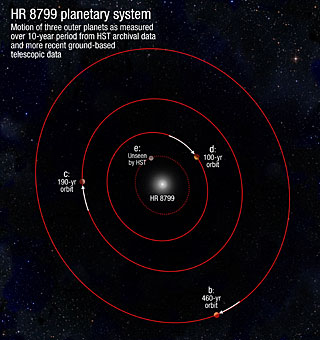
As you can see here, we're oriented almost directly above the system rather than edge on.
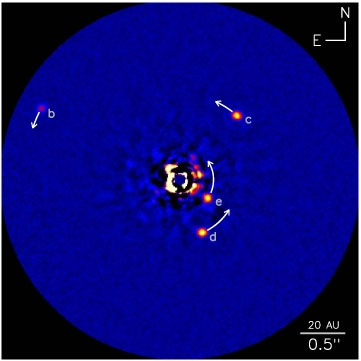
It is no coincidence that our fictional story's two observatories are located in the same places. They are home to the largest telescopes in the world and its likely Colossus will be similarly located.
These planets were only visible because the light of the star has been blocked through a technique.

It was made possible by the Keck telescope in Mauna Kea Hawaii and the Gemini telescope in Chile.
This is HR 8799. It's a very bright young star only 30 million years old.
HR 8799 is 120 light years away.

As you can see here, we're oriented almost directly above the system rather than edge on.

It is no coincidence that our fictional story's two observatories are located in the same places. They are home to the largest telescopes in the world and its likely Colossus will be similarly located.
These planets were only visible because the light of the star has been blocked through a technique.
edit on 30-11-2013 by JadeStar because: (no
reason given)
I would be like totally cool if this would happen,
unfortunately ATLAST is not due for launch till 2025 - 2035 period.
Advanced Technology Large Aperture Space Telescope
At last indeed...... probably be 2035 knowing my luck, grrr !
unfortunately ATLAST is not due for launch till 2025 - 2035 period.
Advanced Technology Large Aperture Space Telescope
At last indeed...... probably be 2035 knowing my luck, grrr !
snoopy11
I would be like totally cool if this would happen,
unfortunately ATLAST is not due for launch till 2025 - 2035 period.
Advanced Technology Large Aperture Space Telescope
At last indeed...... probably be 2035 knowing my luck, grrr !
Well If you're talking space telescopes, there's always the possibility of using the James Webb Space Telescope with a starshade to block the light of the star.
That could happen as soon as 2018-2020.
Have a look at this:
Alien spotting: By 2020, we’ll finally have the ability to locate life-harboring, alien planets - ExtremeTech.com
As exciting as the space telescopes will be I am almost more excited about some of the massive ground based telescopes that are planned or under construction.
And as I said, there are going to be some crazy big ground based telescopes coming online before 2025 as well. These ground based telescope will rival Hubble and James Webb when it comes to exoplanets.
European Extremely Large Telescope (E-ELT) to be completed in Chile and operational in 2019
Here are some pictures of it compared to the present Very Large Telescopes (VLT) and other large, historic structures.....and an Airbus A340 plane.
Compared to Brandenburg Gate
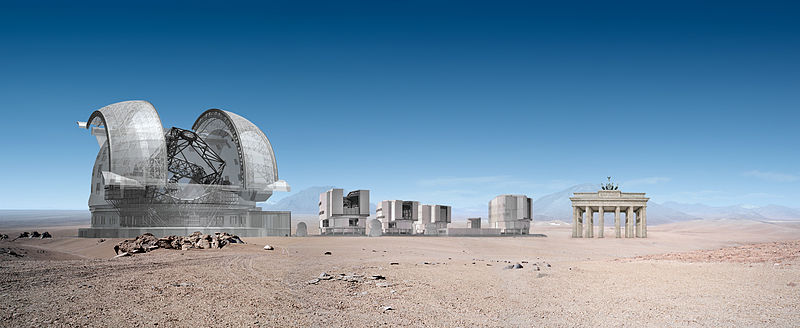
Compared to the Roman Coliseum
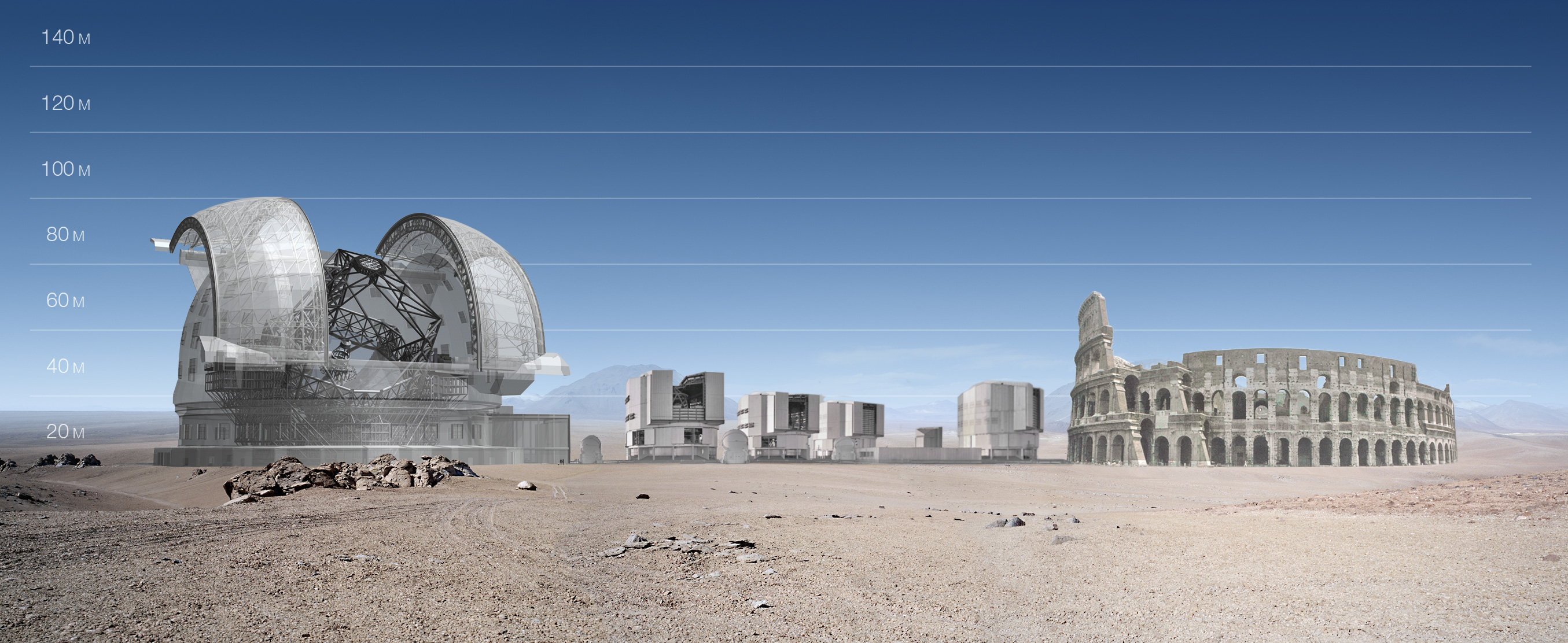
Compared to the Great Pyramid
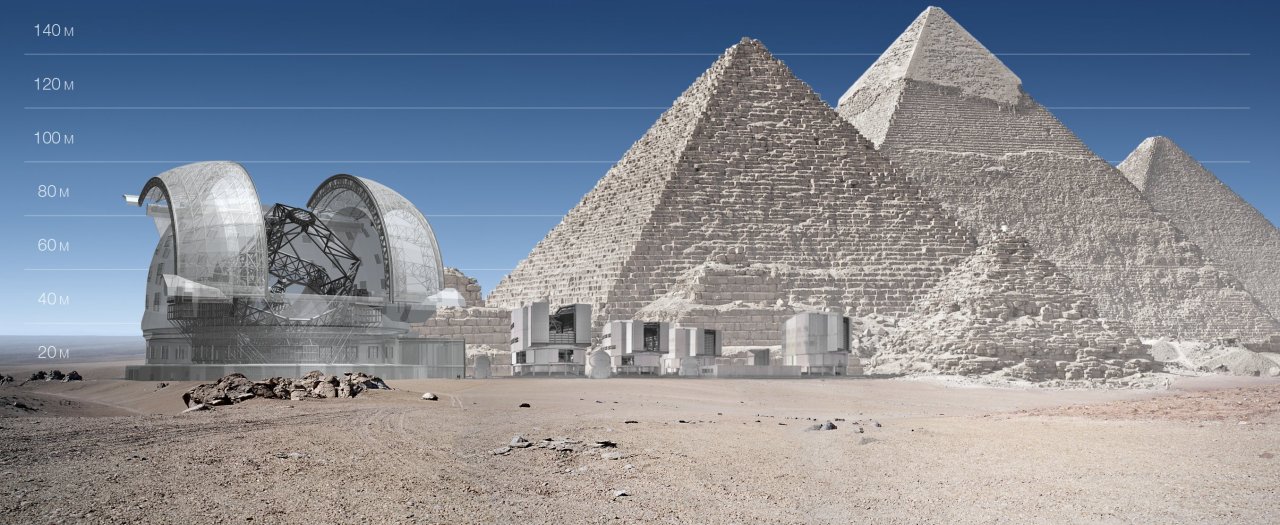
Compared to an Airbus A340
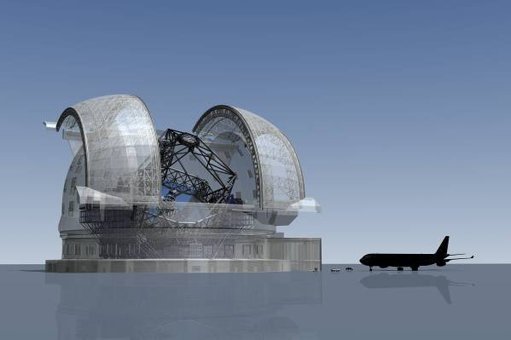
The E-ELT will search for extrasolar planets — planets orbiting other stars. This will include not only the discovery of planets down to Earth-like masses through indirect measurements of the wobbling motion of stars perturbed by the planets that orbit them, but also the direct imaging of larger planets and possibly even the characterisation of their atmospheres.[20] The telescope will attempt to image Earthlike exoplanets, which may be possible.
Not to be outdone, the US is planning to build two massive telescopes with global partners such as Japan, Canada, India and China as well: The Thirty Meter Telescope (TMT) in Hawaii and the Atacama Large Millimeter Array (ALMA) in Chile.
Thirty Meter Telescope (TMT) will sit atop Mauna Kea, Hawaii and begin operations in 2018.
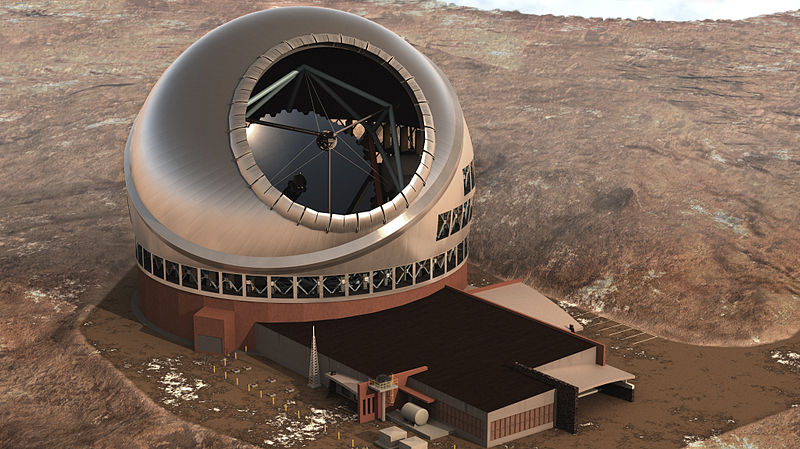
Spectroscopic discovery observations that push into the terrestrial (size) planet regime, the kinematics of proto-planetary disks, spectroscopic detection and analysis of extra-solar planet atmospheres and the direct detection of extra-solar planets in reflected and emitted light are all goals that are driving the TMT design requirements.
Atacama Large Millimeter Array (ALMA) in Chile, the prototype went operational early this year in 2013
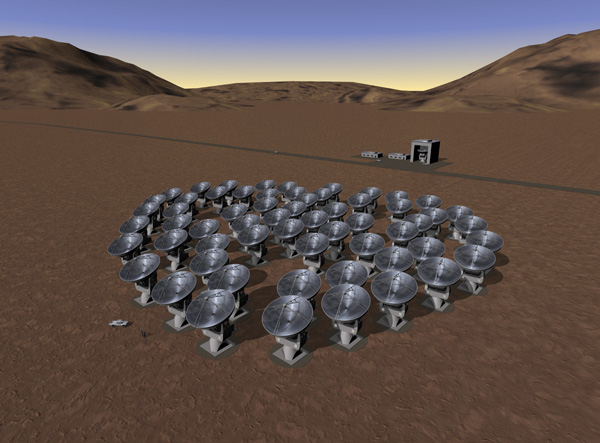
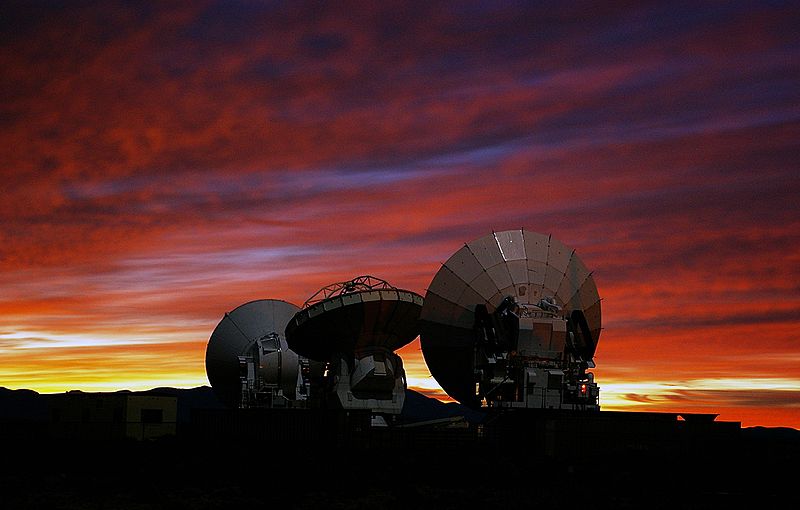
ALMA will make substantial contributions to the observations of extrasolar planetary systems at all evolutionary stages. In particular, there are four areas in which ALMA will be able to aid in the investigation of extrasolar planets and planetary systems:
ALMA will be able to directly detect forming giant planets (“condensations”) in protoplan-
etary disks, and the gaps created in these disks as the condensations grow.
ALMA will be able to directly detect very young giant planets in the nearest star forming
regions.
ALMA will be able to indirectly detect the presence of giant planets around nearby stars
through the use of astrometry. These observations are absolutely crucial to our understanding of how our own solar system formed, and may help in answering the question of whether we are alone in the universe.
Giant Magellan to be built in Chile and operational in 2020.
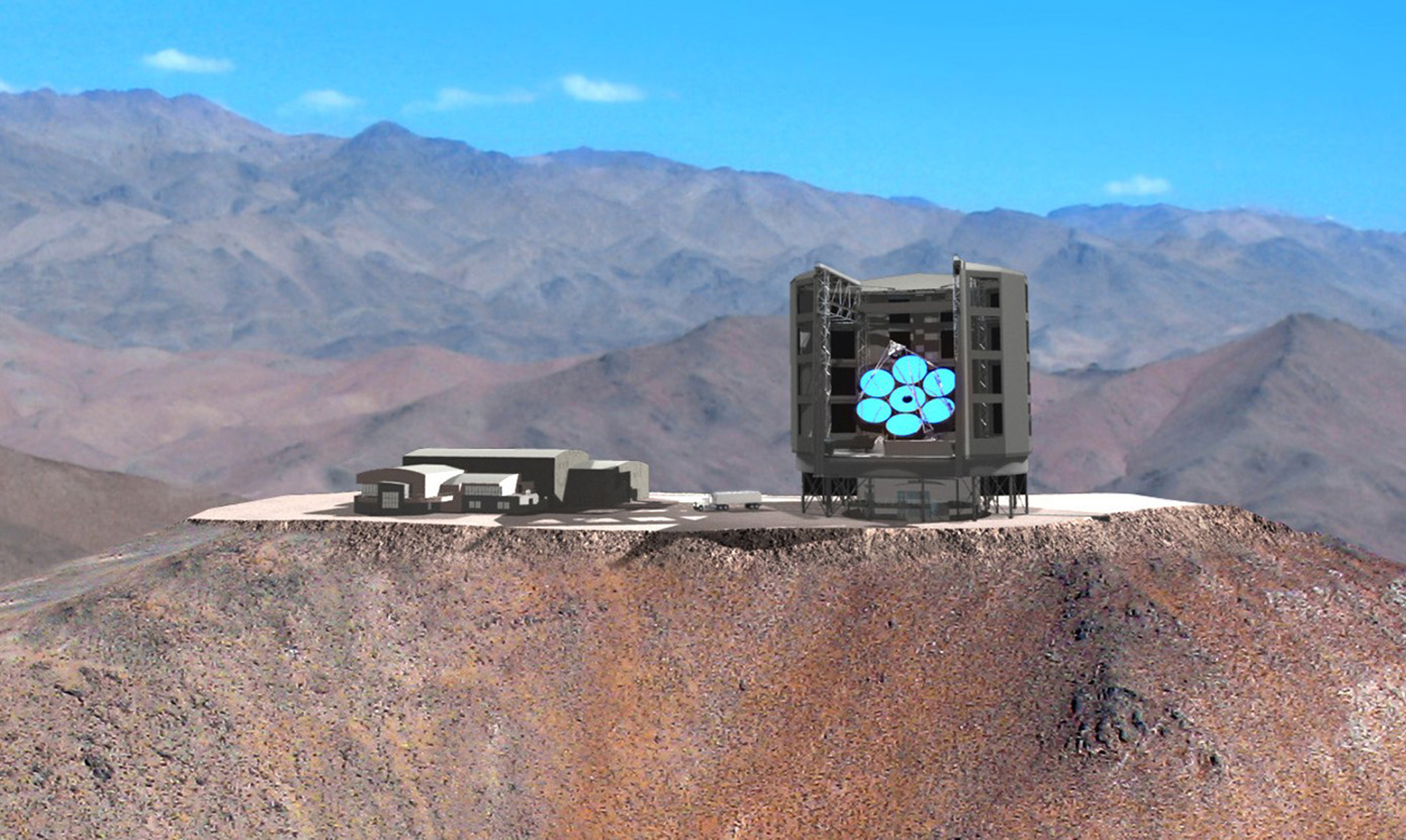
Perhaps one of the most exciting questions yet to be answered is: are we alone? The Giant Magellan Telescope may help us answer that. Finding evidence of life on other planets would be a momentous discovery--certainly one of the greatest in the history of human exploration. But taking pictures of these so called "extrasolar" planets, which orbit other stars, is extraordinarily difficult. In addition to the vast distance--the very closest star to earth is four light-years away--the biggest problem is the glare of the host star which blocks out most of the reflected light of a small distant planet.
And the previous mentioned Colossus telescope which serves at the discovery site for our story. It possibly will be built on Mauna Kea in Hawaii.
Unlike Colossus those other telescopes are actually fully funded and being built by governments at the moment. Colossus will be entirely privately funded and could be online by 2019 if someone wants to help pick up the billion dollar price tag (Google seemed like a good partner for the story. They're all about search and categorization. After all, what's the biggest search and categorization question in the universe? How many ETs are out there? )
Colossus
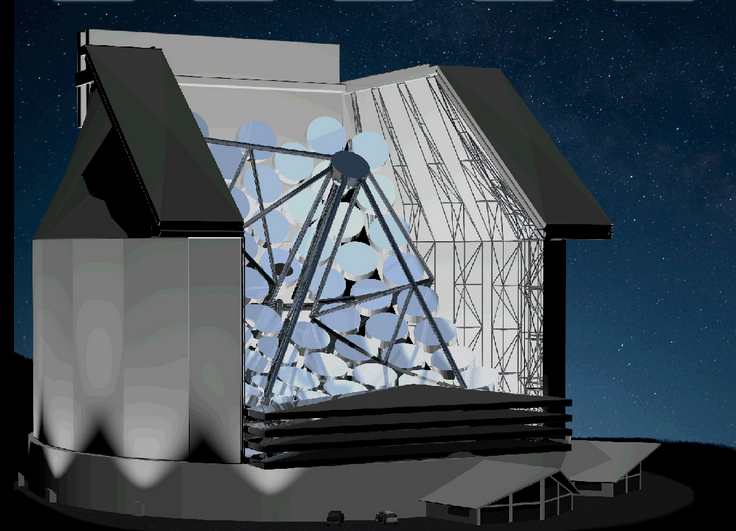
The detection of an extraterrestrial civilization (ETC), even without further communication, is important in many gnostic and practical aspects. For instance, one of the current burning issues for our civilization is surviving global climate changes because of increasing power generation. Detecting more advanced civilizations will demonstrate a fundamental possibility that civilization can achieve a phase of sustainable global-scale power consumption.
For a half-century we have sought radio frequency evidence and, more recently, optical communications of ETCs. However, these approaches depend on finding alien transmissions, beam "leakage", or what could be called intentional electromagnetic signals from ETCs that are operating cosmic beacons.
The Colossus will employ a strategy for detecting an unintentional signal caused by alien planetary warming. Thanks to its large aperture and unique coronographic properties, it will be capable of detecting the thermodynamic signal from Earth-like ETC's within an interestingly large cosmic volume. The outcome of such a dual wavelength, visible-IR, search will be largely independent of alien communication modes and will have quantifiable statistical completeness. Even a null result will help us understand the Fermi paradox, "why do we appear to be alone?"
Detecting an ETC signal is possible with current technology but requires a telescope and sensitive detector that can measure the planet's thermal flux and its reflected optical light, while distinguishing these from the star's scattered light and the terrestrial thermal noise background. Glare from the central star comes from the terrestrial atmosphere's distorting effect on the optical wavefront and from diffraction due to telescope optics. Suppressing this noise requires highly accurate adaptive optics (AO) and a coronagraph system. These requirements are implemented in the Colossus design. We will be able to see advanced civilization heat pattern as can be seen in night lights on the Earth from space
If all of this gets you as excited as me then you might be interested in this article over on Discovery News as well: 13 Ways to Hunt Intelligent Aliens
edit on 30-11-2013 by JadeStar because: (no reason given)
Also if you liked the story check out this episode of Podcast UFO where exoplanet research was talked about in detail:
Podcast UFO: Episode 73 - Marc D'Antonio
UFO News roundup along with Peggy, then an interview with Marc D’Antonio, who is an astronomer and MUFON’s Chief Photo/Video Analyst discussing mostly exoplanets.
Podcast UFO: Episode 73 - Marc D'Antonio
I'm curious about something, based on the info I've been researching and putting forward in this thread.
Why is the Earth analogue being largely ignored, whereby the assumption for the expectation for Earth-like worlds is one where seemingly almost any sort of configuration might do, which seems to me to be an almost narcissistic-like projection (without basis in fact or reality) combined with the apparent hope (also irrational) of somehow reducing the uniqueness and specialness of life on Earth?
I am not arguing for Earth-like exclusivity to Earth only, but from the research I've done and have been doing, it's beginning to look more and more like Earth hangs on a very thin razors edge (I believe according to a selection bias aka by design) in favor of Earth-like life as we know it.
Like I said before, just being in the Habitable Zone (wherein liquid water is possible) or the "Goldilocks Zone" doesn't mean that the "porridge" is going to be "just right".
This does not mean to say that life in some form wherever possible isn't ubiquitous, only that an Earth-LIKE world is and must be considered exceedingly rare (unless design elements are present in the Earth analogue), particularly if we are to accept the standard model of lunar formation (random collision ie: by mere fluke or coincidence, and not by design with intent and thus by anticipation from a first cause).
To clarify a little bit from a previous post.
That said, because there IS an Earth-analogue and so many stars in our galaxy, it's well worth the search to look for them or other types of configurations that could allow for the evolution of life of some kind, and indeed this is certainly the greatest scientific exploration process ever undertaken in the history of human civilization.
Best Regards,
NAM
Why is the Earth analogue being largely ignored, whereby the assumption for the expectation for Earth-like worlds is one where seemingly almost any sort of configuration might do, which seems to me to be an almost narcissistic-like projection (without basis in fact or reality) combined with the apparent hope (also irrational) of somehow reducing the uniqueness and specialness of life on Earth?
I am not arguing for Earth-like exclusivity to Earth only, but from the research I've done and have been doing, it's beginning to look more and more like Earth hangs on a very thin razors edge (I believe according to a selection bias aka by design) in favor of Earth-like life as we know it.
Like I said before, just being in the Habitable Zone (wherein liquid water is possible) or the "Goldilocks Zone" doesn't mean that the "porridge" is going to be "just right".
This does not mean to say that life in some form wherever possible isn't ubiquitous, only that an Earth-LIKE world is and must be considered exceedingly rare (unless design elements are present in the Earth analogue), particularly if we are to accept the standard model of lunar formation (random collision ie: by mere fluke or coincidence, and not by design with intent and thus by anticipation from a first cause).
To clarify a little bit from a previous post.
NewAgeMan
I've been able to discern from the research that I've done so far, that the innermost planets of a solar system, including those in the "Habitable Zone" have a tenancy to either tidal lock with their host star, or, at best, to have a very very very slow rate of rotation, on the way to tidal locking, and that indeed - the reason that the Earth is not tidally locked and spins so fast, at 366 times per orbit, is due to the counteracting tidal force of our single, giant moon, out of 166 in our solar system, which has the 2nd highest density, behind Io, and, that is the largest natural satellite of a planet in the Solar System relative to the size of its primary, having 27% the diameter and 60% the density of Earth.
It should also be noted, as a sideline factoid, that Mercury has no moon and neither does Venus. Earth has one of course, and of the remaining five planets, not including Pluto, there are 164 moons (or more), the vast majority of which circle the massive Gas Giant, Jupiter.
That said, because there IS an Earth-analogue and so many stars in our galaxy, it's well worth the search to look for them or other types of configurations that could allow for the evolution of life of some kind, and indeed this is certainly the greatest scientific exploration process ever undertaken in the history of human civilization.
Best Regards,
NAM
edit on 30-11-2013 by NewAgeMan because: (no reason given)
They are looking for Earth analogues, and there is one KOI that fits the bill which will probably be the first one if and when it is confirmed.
The reason you see so much other research of just planets in the habitable zone in general is because we still only have one example of a planet in the habitable zone which has life. It would be very narrow to assume that one example is the most common one or the norm.
Remember, Marcy and Butler made that mistake with regards to extrasolar planets around sunlike stars in general. They were looking for a star system with the same configuration as our solar system, meanwhile the Swiss made the first discovery by not making such an assumption.
There are a fair amount people in the field who suspect that the first planet we find with life outside the solar system will be around an M or K star rather than a G one like our sun due to M and K stars being more numerous than G stars and some of the instruments/missions being biased towards these stars for technical reasons.
So it would be silly to spend all that time looking for an Earth analog only to find that a ton of other types of planets had life on them.
There are various ideas as to what has more or less of an influence on habitability and that is why this whole area is exciting, we have more questions than answers so its best to build the instruments and investigate without too many assumptions.
So when you see habitable zone planets mentioned keep in mind we still don't know much about them, that's what the next decade is about.
Cast a wide net, and narrow down the possibilities makes more sense than look for a narrow possibility then expand outward from it.
The reason you see so much other research of just planets in the habitable zone in general is because we still only have one example of a planet in the habitable zone which has life. It would be very narrow to assume that one example is the most common one or the norm.
Remember, Marcy and Butler made that mistake with regards to extrasolar planets around sunlike stars in general. They were looking for a star system with the same configuration as our solar system, meanwhile the Swiss made the first discovery by not making such an assumption.
There are a fair amount people in the field who suspect that the first planet we find with life outside the solar system will be around an M or K star rather than a G one like our sun due to M and K stars being more numerous than G stars and some of the instruments/missions being biased towards these stars for technical reasons.
So it would be silly to spend all that time looking for an Earth analog only to find that a ton of other types of planets had life on them.
There are various ideas as to what has more or less of an influence on habitability and that is why this whole area is exciting, we have more questions than answers so its best to build the instruments and investigate without too many assumptions.
So when you see habitable zone planets mentioned keep in mind we still don't know much about them, that's what the next decade is about.
Cast a wide net, and narrow down the possibilities makes more sense than look for a narrow possibility then expand outward from it.
edit on
30-11-2013 by JadeStar because: (no reason given)
reply to post by JadeStar
Thanks for clarifying.
Thus the fundamental assumptions I'm making because they are based on OUR system as an analogue, might not apply, with regards to tidal locking or the number of planets in from or outside the habitable zone, distances, and rates of rotation, because there's so much variety as our own solar system reveals, there could be a pair of planets in the habitable zone embraced in a dance, like Pluto and Charon or a "binary planet" circling another type of star altogether, thus distances and every kind of variation are going to be happening... hmmm that's a game changer, that amount of variety, puts less contraints on what's possible, but it also increases the unknown and unknowability of it, which is why this is so exciting, because each discovery involves, not just ruling out a negative, but validating a positive, so the data is decisive and confirming or validating, which need not imply an Earth-analogue at all. Changes the nature of the question being posed. Thanks again.
I've have to totally re-evaluate now... but I do still have a certain hypothesis I'd like to offer within this new context.
I knew that I was missing something an essential piece of the puzzle and this is it.
Regards,
NAM
Thanks for clarifying.
Thus the fundamental assumptions I'm making because they are based on OUR system as an analogue, might not apply, with regards to tidal locking or the number of planets in from or outside the habitable zone, distances, and rates of rotation, because there's so much variety as our own solar system reveals, there could be a pair of planets in the habitable zone embraced in a dance, like Pluto and Charon or a "binary planet" circling another type of star altogether, thus distances and every kind of variation are going to be happening... hmmm that's a game changer, that amount of variety, puts less contraints on what's possible, but it also increases the unknown and unknowability of it, which is why this is so exciting, because each discovery involves, not just ruling out a negative, but validating a positive, so the data is decisive and confirming or validating, which need not imply an Earth-analogue at all. Changes the nature of the question being posed. Thanks again.
I've have to totally re-evaluate now... but I do still have a certain hypothesis I'd like to offer within this new context.
I knew that I was missing something an essential piece of the puzzle and this is it.
Regards,
NAM
It seems clear that the idea of extraterrestrial intelligent life is driving not only the imagination of many persons, but also a substantial amount
of cutting- edge science. Without meeting us openly, ETs can, in a sense, be said to already be influencing our culture to a notable degree.
This idea is motivating us to the effort necessary to bring about an eventual encounter with our galactic neighbors. The supposition that we are not alone in the universe is, in essence, a self-fulfilling prophecy.
This idea is motivating us to the effort necessary to bring about an eventual encounter with our galactic neighbors. The supposition that we are not alone in the universe is, in essence, a self-fulfilling prophecy.
edit on 1-12-2013 by Ross 54 because: (no reason given)
Ross 54
It seems clear that the idea of extraterrestrial intelligent life is driving not only the imagination of many persons, but also a substantial amount of cutting- edge science. Without meeting us openly, ETs can, in a sense, be said to already be influencing our culture to a notable degree.
This idea is motivating us to the effort necessary to bring about an eventual encounter with our galactic neighbors. The supposition that we are not alone in the universe is, in essence, a self-fulfilling prophecy.edit on 1-12-2013 by Ross 54 because: (no reason given)
Indeed Ross,
And on that note here is some more cutting edge science.
If any of you is into Michio Kaku's referencing to Type I, Type II and Type III civilizations then you'll like this talk about using the Wide Infrared Survey Explorer to look for Type II and Type III civilizations.
It also talks about interstellar travel and colonization.
edit on 4-12-2013 by JadeStar because: (no reason given)
I'm not sure what happened to the video but here it is again.
Also the US House of Representatives held a discussion on finding extraterrestrial life through detecting biosignatures this week:
Also the US House of Representatives held a discussion on finding extraterrestrial life through detecting biosignatures this week:
I'm bumping this because the real life Colossus project has made some headway recently.
A presentation was given at the "Search for Life Beyond the Solar System:
Exoplanets, Biosignatures and Instruments" conference hosted by the University of Arizona and Vatican Observatory back in March of this year (2014) which you can access at NASA here
Colossus was presented to the SPIE—The International Society for Optical Engineering.
A talk by Jeff Kuhn at TEDx Honolulu was given on how the Colossus project could benefit the education of humanity:
Also here was a talk I meant to post given by Svetlana Berdyugina from the Colossus project at TEDx in Maui, Hawaii called "Finding Alien Life -- Pushing beyond limits".
A presentation was given at the "Search for Life Beyond the Solar System:
Exoplanets, Biosignatures and Instruments" conference hosted by the University of Arizona and Vatican Observatory back in March of this year (2014) which you can access at NASA here
Colossus was presented to the SPIE—The International Society for Optical Engineering.
A talk by Jeff Kuhn at TEDx Honolulu was given on how the Colossus project could benefit the education of humanity:
Also here was a talk I meant to post given by Svetlana Berdyugina from the Colossus project at TEDx in Maui, Hawaii called "Finding Alien Life -- Pushing beyond limits".
edit on 19-12-2014 by JadeStar because: (no reason given)
originally posted by: SCITK
Even sceptics understand the odds of our planet being the only one with self-conscious life in entire universe is simply statistically impossible.
Statistically impossible? Hardly. There are probably close to an infinite number of unique things in the universe. Things that happened just once and will never, ever... EVER happen again. Like you being born, for instance. Only happened once, right? You don't think there are tens of thousands of "yous" running around in the universe, do you?
So just imagine that the thing that allowed life to happen -- the thing that took a bunch of dead, disorganized chemicals and happened to hook them together in such a way that it reproduced, and eventually had a point of view -- was about as likely as you showing up in the universe. Only once.
The only way to prove it happened more than once is to find another planet with life on it. AND THEN the most we can say is that it happened at least twice, but there is no guarantee that it happened a third time.
edit on 19-12-2014 by Blue Shift because: (no reason given)
begin organizing lobbying groups for all of the following:
more scope time
more scopes
full funding for development of propulsion systems that could be done near term such as NEP, NTR, Fusion, VASIMR, M2P2...
full funding for research for closed loop life support, impact avoidance, AI and other needed tech for probes or manned flight.
better funding for high risk high payoff speculative propulsion and related science.
drawing the plans, schematics and specifications for the first series of interstellar probes.
getting the world to decide whether trying to actively send signals to the detected civilization is rational and worth the risk to us. that's gonna be messy.
more scope time
more scopes
full funding for development of propulsion systems that could be done near term such as NEP, NTR, Fusion, VASIMR, M2P2...
full funding for research for closed loop life support, impact avoidance, AI and other needed tech for probes or manned flight.
better funding for high risk high payoff speculative propulsion and related science.
drawing the plans, schematics and specifications for the first series of interstellar probes.
getting the world to decide whether trying to actively send signals to the detected civilization is rational and worth the risk to us. that's gonna be messy.
new topics
-
UK and Europe Floods
Rant: 57 minutes ago -
FEMA kicks hurricane survivors out of temporary housing into snowstorm and freezing temperatures
Disaster Conspiracies: 1 hours ago -
Failures of leadership on display
US Political Madness: 1 hours ago -
Power grid faults surged right before Los Angeles wildfires began
Mainstream News: 1 hours ago -
Tustin California Military equipment stolen BIG equipment .
Social Issues and Civil Unrest: 1 hours ago -
PALES-TINE, PALES-ADES and the Australian Aboriginal "Lightning Man"
Dreams & Predictions: 2 hours ago
top topics
-
Tustin California Military equipment stolen BIG equipment .
Social Issues and Civil Unrest: 1 hours ago, 10 flags -
Failures of leadership on display
US Political Madness: 1 hours ago, 8 flags -
FEMA kicks hurricane survivors out of temporary housing into snowstorm and freezing temperatures
Disaster Conspiracies: 1 hours ago, 8 flags -
How To Spot Fake U.F.O. Photos
Aliens and UFOs: 13 hours ago, 7 flags -
Scary video of face in an abandoned house
Paranormal Studies: 15 hours ago, 6 flags -
Power grid faults surged right before Los Angeles wildfires began
Mainstream News: 1 hours ago, 6 flags -
PALES-TINE, PALES-ADES and the Australian Aboriginal "Lightning Man"
Dreams & Predictions: 2 hours ago, 5 flags -
UK and Europe Floods
Rant: 57 minutes ago, 3 flags
active topics
-
This should be plastered all over the airwaves
Mainstream News • 58 • : fringeofthefringe -
Los Angeles brush fires latest: 2 blazes threaten structures, prompt evacuations
Mainstream News • 402 • : BeyondKnowledge3 -
FEMA kicks hurricane survivors out of temporary housing into snowstorm and freezing temperatures
Disaster Conspiracies • 6 • : Astrocometus -
Failures of leadership on display
US Political Madness • 5 • : tkwaz -
Fire insurance in LA withdrawn months ago
General Conspiracies • 40 • : xuenchen -
Instrumental Surf Music - Origins to the Present Day
Music • 251 • : underpass61 -
Power grid faults surged right before Los Angeles wildfires began
Mainstream News • 3 • : fringeofthefringe -
Mood Music Part VI
Music • 3783 • : underpass61 -
Post A Funny (T&C Friendly) Pic Part IV: The LOL awakens!
General Chit Chat • 8016 • : underpass61 -
Could the Civil War have been about piracy?
History • 8 • : Solvedit

